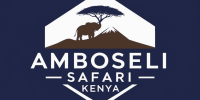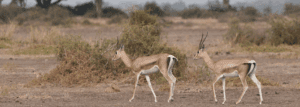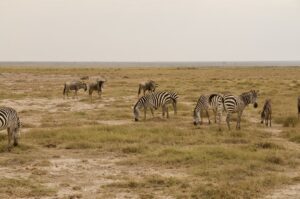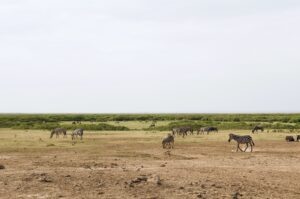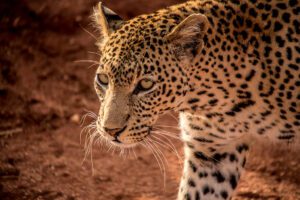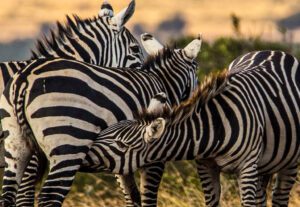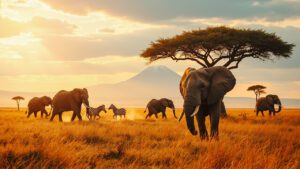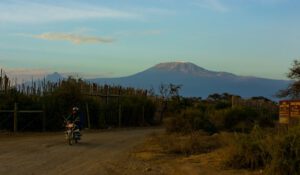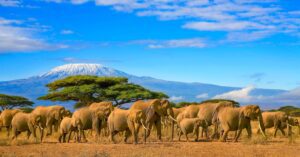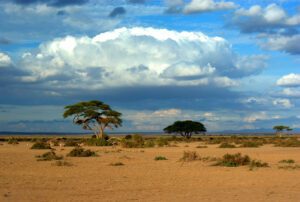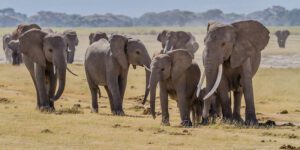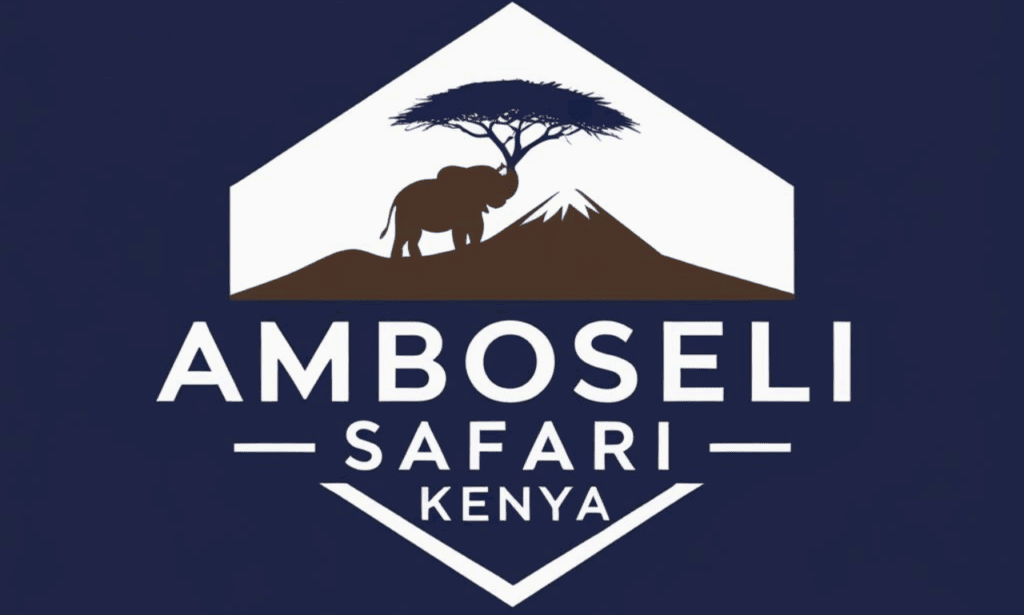What is an Amboseli Day Trip?
An Amboseli Day Trip is a short yet exciting journey to Amboseli National Park, one of the most famous wildlife destinations in Africa. This trip typically starts early in the morning, allowing visitors to enjoy a day of game drives, exceptional wildlife sightings, and soaking in the beauty of the park before returning in the evening. Amboseli is world-famous for its large elephant herds and breathtaking views of Mount Kilimanjaro, the highest mountain in Africa, making it a perfect safari experience.
A day trip is ideal for those who may not have enough time for a multi-day safari or for travelers in Nairobi who want a quick escape into nature. It’s about experiencing the wilderness without the need to spend nights in the park, making it more affordable and convenient for adventurers seeking a glimpse of the African savanna country.
The trip usually offers opportunities to observe wildlife, take stunning photos, and learn about the local ecosystem. Safari guides often provide information on the animals, plants, and culture surrounding Amboseli Park. Visitors will also get the chance to interact with breathtaking landscapes, including the open savannah, wetlands, and acacia woodlands, all while spotting iconic species like giraffes, zebras, and wildebeests.
For example, you might leave Nairobi early in the morning, drive for about 4-5 hours to Amboseli, spend the day exploring its attractions, and then return to the city in the evening. It’s a thrilling way to experience a safari tour in one of Africa’s most iconic parks, all within one day!
Where is Amboseli located and how do I get there?
Amboseli National Park, a gem in southern Kenya, is located near the border with Tanzania. It’s approximately 240 kilometers (about 150 miles) southeast of Nairobi, Kenya’s capital city, and the journey takes around 4-5 hours by road, depending on the route and traffic. Visitors often seek an Africa Kenya safari experience to witness the stunning landscapes and wildlife that this park has to offer.
There are two main ways to reach Amboseli: by road or by air. Most people drive from Nairobi using private vehicles, tour vans, or safari jeeps. The trip usually passes through towns like Emali or Athi River, branching off to a scenic route toward the park. While the roads are passable, some stretches might not be very smooth, especially near the park entrance, which adds to the adventure of an African safari.
You can also opt for a domestic flight from Nairobi’s Wilson Airport to Amboseli’s airstrip, which takes about 45 minutes. This is quicker but can be more expensive and is usually included in luxury safari packages. Once at the airstrip, a guide or pre-arranged vehicle will take you around the park for the day, showcasing the magnificent wildlife and breathtaking views of Mt. Kilimanjaro.
For an easier experience, many visitors join organized tours, where transport, park entry fees, and guides are all included. A typical tour might include hotel pickup in Nairobi, transportation to Amboseli, a day of game viewing, and then a return trip to the city. Whether by road or air, Amboseli’s location makes it accessible for a perfect day trip, allowing adventurers to explore the amazing wildlife of the African savanna country!
What are the main attractions in Amboseli National Park?
Amboseli National Park offers numerous attractions that make it a favorite destination for wildlife lovers and travelers seeking incredible landscapes.
One of the biggest highlights of Amboseli is the iconic view of Mount Kilimanjaro. While the mountain itself is in Tanzania, its snow-capped peaks serve as a stunning backdrop for the park, especially during sunrise and sunset. It’s a view you’ll see on countless postcards and is even more breathtaking in person!
Another major attraction is Amboseli’s large population of elephants. You can often see herds of them up close as they roam freely across the open plains. These elephants are among the most well-documented in Africa due to decades of observation and research. Other animals in the park include lions, cheetahs, zebras, giraffes, wildebeests, buffaloes, and various types of antelope.
The park also has unique ecosystems, including dusty plains, swamps, and marshes created by underground springs fed by Mount Kilimanjaro. These wetlands attract a variety of birds, including flamingos, pelicans, and eagles, making this park a haven for bird lovers.
Cultural experiences are another attraction, as many tours include visits to nearby Maasai villages. Here, you can learn about the Maasai way of life, view traditional dances, and even buy handcrafted souvenirs like beadwork or jewelry.
A popular activity is the game drive, where vehicles drive through the park, allowing visitors to spot animals in their natural habitat. Photographers also love Amboseli for its dramatic views, imagine snapping a picture of an elephant with Mount Kilimanjaro looming majestically in the background!
In short, visiting Amboseli brings together extraordinary wildlife, culture, and unforgettable scenery. It’s truly a highlight of any trip to Kenya.
How much does an Amboseli Day Trip typically cost?
The cost of an Amboseli Day Trip can vary depending on a few factors, like the type of tour package you choose, the transportation option, and whether meals and guide services are included. Typically, the price falls within the range of $150 to $300 USD per person.
A lower-cost trip might involve sharing transportation in a group tour, while higher-priced packages often include private safari vehicles, more customized experiences, and meals. For example, if you’re taking a group van from Nairobi (about a 4-hour drive from Amboseli), the price per person tends to be more affordable compared to hiring a private 4×4 safari vehicle.
The entrance fee to Amboseli National Park is also a key part of the cost. For non-residents (tourists visiting Kenya), the park entry fee is $60 per adult. Kenyan citizens or residents usually pay much less. Make sure to clarify with your tour operator whether the entry fee is included in the trip cost, as this can sometimes come as a surprise expense.
If you’re arranging your own transportation and visiting without a guide, costs will mostly depend on fuel for your vehicle and the entry fees. However, keep in mind that a guided tour often maximizes your experience and makes spotting wildlife easier, as guides know where to find animals and navigate the park better.
Additional costs can include tips for the guide and driver, buying souvenirs, and optional add-ons like picnic lunches. So, plan your budget accordingly!
What kind of wildlife can I expect to see in Amboseli?
Amboseli National Park is famous for its wildlife, especially large herds of elephants. Imagine seeing elephants walking together in groups against the backdrop of the stunning Mount Kilimanjaro; this is one of the iconic Africa Kenya safaris experiences. Sometimes you’ll spot adorable baby elephants sticking close to their mothers, creating heartwarming scenes.
Aside from elephants, Amboseli is home to many other animals. You might see lions lazing under a tree or looking for prey, giraffes munching on tree leaves, and zebras grazing on the grasslands. If you’re lucky, you could even catch a glimpse of cheetahs or leopards, although they are harder to find since they excel at hiding. Hippos can also be seen in the park’s swampy areas, along with buffalos towering over smaller grazing animals.
Amboseli is also a great destination for birdwatchers. With over 400 bird species in the park, you might see flamingos, African fish eagles, pelicans, ostriches, or colorful little birds called kingfishers. Whether you’re into big mammals or beautiful birds, Amboseli offers it all, making it a perfect safari destination.
One of the main reasons animals love Amboseli is because of its swamps and wetlands, which are fed by underground water from Mount Kilimanjaro. Even during dry seasons, many animals gather here to drink, feed, or find shade, making wildlife sightings easy year-round.
In short, if you visit Amboseli, expect an exciting mix of animals all existing in one picturesque park, and don’t forget to bring a good camera for all the incredible photo opportunities that await in this magnificent wildlife sanctuary!
What’s the best time of year to visit Amboseli for a day trip?
The best time to visit Amboseli for a day trip is during the dry seasons in Kenya, which are from June to October and January to February. Here’s why these months are ideal:
In the dry season, animals tend to gather around the park’s water sources, like the swamps and springs, making them easier to spot. Since there’s less vegetation during this time, you get clearer views of the wildlife, and it’s not as easy for them to hide. The roads in the park are also in better condition because there’s no rain to make them muddy.
Another big reason to visit during the dry season is for the stunning views of Mount Kilimanjaro. Amboseli sits right below this giant mountain, and during the dry months, the skies are usually clear in the mornings and evenings. This means breathtaking sights and perfect photo opportunities, especially with wildlife in the foreground and Kilimanjaro as a backdrop.
Although the wet seasons (March to May and November to December) aren’t terrible, they come with some challenges. Heavy rains can make sections of the park difficult to navigate, and spotting animals can be harder because of thicker green vegetation. However, the wet season also has its perks: the landscape looks lush and green, and it’s a great time to see baby animals. Birdwatchers will also love this time, as migratory birds flock to Amboseli.
In conclusion, if you want the best chance to see animals, avoid muddy roads, and get postcard-perfect views of Mount Kilimanjaro, aim for the dry season months. Morning game drives during this time are particularly magical. But even during other times of the year, Amboseli is always worth visiting!
How long does the day trip usually take, and what is the itinerary like?
An Amboseli Day Trip typically takes one full day, beginning early in the morning and ending in the evening. The trip can last around 10 to 12 hours, depending on your starting point and how long you spend in the park. For most visitors coming from Nairobi, it’s approximately a 4-hour drive to Amboseli National Park, renowned for its exceptional wildlife sightings. This means the entire journey will involve a good amount of driving alongside the time spent exploring the park’s stunning landscapes, including the iconic Mt Kilimanjaro and the vast African savanna country.
Here’s a sample itinerary to give you an idea of what to expect during your Amboseli safari. While itineraries may vary depending on the tour operator, self-guided visitors will likely follow a similar timeline. The important thing to remember is to leave early and plan your day well to maximize your time in Amboseli Park, where you can enjoy sightings of majestic elephants and graceful giraffes roaming freely.
- Early Morning Departure: Most tours or trips start at around 5:00 or 6:00 AM, especially if you’re coming from Nairobi. This ensures you arrive at the park in the morning and have enough time for wildlife viewing. The early departure also increases the chances of spotting animals since many are most active in the cooler parts of the day.
- Arrival at Amboseli: You’ll likely arrive at the park around 9:00 or 10:00 AM. At the entrance, you’ll pay your entry fee (or the guide will handle it for you if it’s a guided tour). The park is known for its breathtaking views of Mount Kilimanjaro, so be sure to take it all in as you begin your adventure.
- Game Drives: The bulk of the day is spent on game drives. These are driving tours through the park where you search for wildlife and explore different sections. Amboseli is famous for its large herds of elephants, so you’ll probably encounter them early in your trip. You’ll also come across giraffes, zebras, lions, and more, along with various bird species.
- Lunch Break: Lunch is usually a picnic-style meal enjoyed at one of the park’s designated picnic areas (if self-driving) or at a lodge with a scenic view (if guided). You’ll get some time to relax and take in the serene surroundings.
- Afternoon Exploration: After lunch, you’ll continue with more game drives, possibly visiting key attractions like Observation Hill. This is a great spot to get panoramic views of the park, swampy areas full of hippos, and Mount Kilimanjaro in the background.
- Departure from Amboseli: Around mid to late afternoon (usually between 3:00 and 4:00 PM), you’ll wrap up your visit and start the return journey to your starting point, such as Nairobi. This ensures you get back before it gets too late in the evening.
To make the most of your safari tour, be sure to include a morning drive to catch the luminous Kenya sunrise, which provides a breathtaking backdrop for observing the diverse wildlife. Whether you are a first-time visitor or a seasoned traveller, an Amboseli safari offers a perfect opportunity to witness the beauty of the natural world and the rich culture of the indigenous Maasai people.
Are there restrictions or rules to follow while visiting Amboseli National Park?
Yes, there are several important rules and restrictions to follow while visiting Amboseli National Park to ensure your safety, protect the wildlife, and preserve the park environment for future visitors. Let’s break them down in a simple way:
- Stay in Your Vehicle: While on game drives, you’re required to remain inside your car unless you’re in designated areas like observation points or picnic zones. Safety comes first because wildlife in the park is wild, and stepping out puts you at risk of animal attacks.
- No Off-Road Driving: You’re not allowed to drive off the designated tracks and roads in the park. This rule is to protect the delicate ecosystem – driving off-road can damage vegetation, soil, and animal habitats.
- Speed Limits: The speed limit in the park is typically 40 km/h (about 25 mph). Driving slowly helps prevent accidents with animals, which may suddenly cross the road, and also allows you to spot wildlife more easily.
- No Feeding Wildlife: Do not feed the animals. Human food is harmful to animals and can disrupt their natural behavior. Feeding them can also make them associate humans with food, increasing the risk of human-wildlife conflict.
- Quiet Behavior: Amboseli is a peaceful place, so visitors are expected to keep noise levels low. Loud sounds can disturb the animals and ruin the experience for other visitors who are there to enjoy the tranquility of nature.
- Leave No Trash: Littering is strictly prohibited. Always carry your trash with you and dispose of it in designated bins, if available. Keeping the park clean ensures it remains beautiful for everyone.
- Respect the Animals’ Space: It’s important not to get too close to the animals. Maintain a safe distance and avoid crowding them. For instance, you shouldn’t try to get too close to an elephant for a photo, as this could stress the animal and potentially make it aggressive.
- Obey Park Authorities: Follow any instructions or guidance from the park rangers and guides. They’re there to keep both visitors and wildlife safe while also maintaining the park’s rules.
Example Scenario: Imagine you’re driving through Amboseli and come across a lion resting by the road. The park rules would want you to admire the lion from inside the car and not try to startle it or make noise to get a reaction. This way, the animal remains undisturbed, and you’re safe in your vehicle.
By following these rules, you’ll have a respectful, safe, and enjoyable experience while helping conserve Amboseli’s incredible natural environment.
Is a guided tour necessary for an Amboseli Day Trip, or can it be self-guided?
Whether or not you need an Africa Kenya safari guide for your Amboseli Day Trip depends on your travel preferences, comfort with navigating the iconic Amboseli National Park, and how much you want to learn about the amazing wildlife and area.
Guided Tour
- Pros: A guided tour means someone who knows the park well is with you, taking care of all the logistics. Guides are experts at spotting animals and can fill your trip with fascinating information about the wildlife, plants, and park history. They also know the best routes and times to find animals like lions or elephants. Guides can help you understand animal behavior – for example, a guide might tell you why the elephants in Amboseli often gather around the swamps in hot weather.Another key benefit is convenience: many guided tours include transportation, park fees, meals, and even pickup and drop-off from your location. This makes it great for first-time visitors or those unfamiliar with the area.
- Cons: Guided tours are usually more expensive than self-guided trips. You also follow a fixed itinerary, which might not be as flexible if you want to spend more time in a specific area of the park.
Self-Guided Tour
- Pros: Driving yourself gives you more freedom to explore at your pace. You can decide which parts of the park to focus on and how long to stay in each area. You may also save money, especially if you’re splitting the trip with a group of friends or family.
- Cons: The downside of self-driving is that you need to prepare well. That means knowing the park’s layout, understanding wildlife viewing etiquette, and sometimes even dealing with car troubles. You may also miss some animals that a professional guide would spot easily. It can be challenging if it’s your first time in Amboseli or if you aren’t familiar with spotting wildlife.
Recommendation
For first-time visitors or those who want a hassle-free experience, a guided tour is highly recommended because it’s more informative and efficient. If you’re an experienced driver with knowledge of safari etiquette and you enjoy planning your own adventures, a self-guided trip can be a rewarding option.
Both methods can offer an incredible Amboseli experience – it just depends on what works best for you!
What type of clothing, gear, or essentials should I bring for the trip?
When going on an Amboseli Day Trip, it’s important to pack smartly to ensure comfort and enjoyment because you’ll be spending several hours outdoors surrounded by wildlife and nature. Here’s a breakdown of what to bring and why:
For clothing, wear lightweight, breathable, and neutral-colored clothes like beige, tan, or olive green. These colors help you blend into the environment and avoid attracting unnecessary attention from wildlife or insects (especially bugs like tsetse flies, which are drawn to blue or black). Long-sleeved shirts and long pants are highly recommended to protect against sunburn, insect bites, and possible scratches from plants or uneven terrain.
Comfortable walking shoes are essential because you may be walking on uneven ground in viewing areas. Choose something sturdy like sneakers or lightweight hiking shoes rather than sandals. A wide-brimmed hat and sunglasses are also essential, as it can get very sunny in Amboseli. Also, pack sunscreen to protect your skin from harmful UV rays.
For gear, consider bringing binoculars for a closer look at wildlife like elephants, lions, or birds that may be farther away. A good camera with a zoom lens can help you capture beautiful moments without disturbing the animals. Since you’ll be outside for hours, a reusable water bottle is a must to stay hydrated, but ensure it’s filled before you head into the park, as facilities are limited. You might also want to carry a small backpack to store these items along with some snacks, bug spray, a raincoat or poncho (in case of sudden rain), and any personal medication.
Lastly, don’t forget a guidebook or an app about Amboseli wildlife if you’re interested in identifying the animals and birds. These items will make your trip more enjoyable and comfortable.
Are there food and drink facilities available during the day trip?
Amboseli National Park itself has very limited or no food and drink outlets inside, so visitors are often advised to come prepared. Some visitors choose to stay at nearby lodges or picnic at designated spots within the park itself.
If you’re on a guided Amboseli Day Trip, your tour operator often includes meals, snacks, and water in the package, so you won’t have to worry about bringing those items yourself. For example, many tours stop at a nice picnic spot where participants can enjoy their packed lunches. If a meal isn’t included in your package, you’ll need to pack your own food and drinks.
You might find small dining options or cafes in lodges and accommodations around the park’s entrance, but these are typically not accessible during the game drive. If you’re self-driving through Amboseli, keep in mind that there won’t be places to buy food or drinks inside the park, and facilities are sparse. It’s best to stock up before you start your trip.
For drinks, water is the most important thing to carry since Amboseli’s climate can get hot and dry. Carry enough for everyone in your group, dehydration can sneak up on you quickly when exposed to the sun for long periods.
A cooler bag can help keep your drinks cool and your perishable food fresh. If you have dietary restrictions, pack meals and snacks that fit your needs. Observe any guidelines about disposing of trash responsibly, as littering harms the environment and wildlife.
To summarize, while there may be some options outside the park or near its entrance, it’s safest to bring your own food and drinks to fully enjoy your Amboseli Day Trip.
What other activities or experiences can complement the day trip in Amboseli?
An Amboseli Day Trip focuses mostly on wildlife viewing and the breathtaking scenery of the park, but there’s more you can do to make your trip truly special. Here are additional activities or experiences to consider:
- cultural Visits to Maasai Villages Amboseli is located in the heart of Maasai land, and visiting a nearby Maasai village can be a fantastic cultural experience. You’ll get to learn about their traditional way of life, dance and music, and see their unique beadwork or crafts. These visits are often organized through tours and provide insight into the local community’s deep connection with the land and animals.
- Photography Expeditions Amboseli offers stunning landscapes with Mount Kilimanjaro as a backdrop, which makes it a dream for photography enthusiasts. Capture the iconic image of elephants walking beneath the towering mountain or the park’s sunset glow over the wetlands. You could plan to spend extra time focusing on taking memorable photos of nature and wildlife.
- Bird Watching For bird lovers, Amboseli is home to more than 400 species of birds, including flamingos, pelicans, and the African fish eagle. If you’re a birder, carry your binoculars and a bird guide and dedicate some time to spotting these winged beauties.
- Lodge Activities If you have time to extend your stay by a day or two, many lodges near the park provide activities such as guided nature walks, night game drives, bush dining experiences, or relaxing spa treatments overlooking the African plains.
- Combine with Other Parks or Attractions Amboseli is relatively close (a few hours’ drive) to other attractions like Tsavo West National Park or Chyulu Hills. If you’re traveling from Nairobi, consider combining Amboseli with other nearby safari parks like Nairobi National Park for a varied adventure.
- Hot Air Balloon Rides In some cases, there are hot air balloon rides offered near Amboseli, adding a surreal touch to your visit. Imagine floating above the park and seeing herds of elephants and other wildlife from the sky.
Adding these experiences can enhance your day trip or provide options for a longer adventure in Amboseli’s beautiful, adventurous environment.
